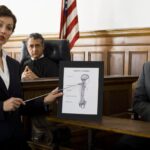Car accident no injury lawyer services are surprisingly common. While many associate car accidents with visible injuries, significant legal issues can arise even without immediate physical harm. This often overlooked area of law addresses the various types of damages that can occur, from emotional distress to lost wages, and explores how to navigate the legal complexities of pursuing a claim. Understanding the nuances of these “no injury” cases is crucial for anyone involved in a car accident, regardless of apparent physical trauma.
This guide delves into the process of seeking legal representation after a car accident where no visible injuries are present. We’ll explore the legal procedures, evidence gathering, negotiation strategies, and potential challenges involved. We also address the vital roles of medical professionals and insurance companies, as well as ethical considerations for lawyers handling these sensitive cases. The goal is to equip individuals with the knowledge needed to protect their rights and pursue fair compensation.
Understanding Client Needs
Clients seeking legal representation after a car accident, even without immediately apparent injuries, often face complex situations requiring the expertise of a “car accident no injury lawyer.” These individuals may not have visible wounds, but they still experience significant consequences from the accident, necessitating legal counsel to protect their rights and pursue fair compensation. Understanding their needs is crucial for effective legal representation.
The typical client in this situation is someone involved in a car accident where the immediate physical injuries are minimal or seemingly nonexistent. They may have walked away from the accident without needing immediate medical attention, perhaps only experiencing minor aches and pains. However, this initial lack of visible injury doesn’t negate the potential for serious, long-term consequences, both physically and financially. These clients often feel overwhelmed by the complexities of insurance claims, medical bills that may arise later, and the potential for future health problems. They seek legal guidance to navigate this challenging situation and ensure they receive appropriate compensation for their losses.
Common Scenarios Requiring Legal Representation
Several scenarios illustrate why someone might need a car accident no injury lawyer despite the absence of obvious injuries. These scenarios highlight the hidden costs and long-term consequences that often emerge after seemingly minor accidents.
- Delayed Onset of Injuries: Whiplash, for example, is a common injury that may not manifest immediately after an accident. Symptoms such as neck pain, headaches, and dizziness can develop days or even weeks later, making it difficult to establish a direct link between the accident and the injury without proper documentation and legal support.
- Aggravation of Pre-existing Conditions: A seemingly minor fender bender could aggravate a pre-existing condition, such as back pain or arthritis. Demonstrating that the accident worsened the pre-existing condition and quantifying the increased pain and suffering requires medical evidence and legal expertise.
- Property Damage and Financial Losses: Even without personal injuries, the accident could result in significant property damage to the vehicle. Negotiating with insurance companies to secure fair compensation for repairs or replacement, as well as lost wages due to time off work to handle the aftermath of the accident, can be significantly easier with legal assistance.
Potential Long-Term Effects of Seemingly Minor Car Accidents
The long-term consequences of seemingly minor car accidents are often underestimated. While immediate injuries may be absent or appear insignificant, various issues can arise over time, impacting the client’s physical and financial well-being.
The lack of immediate symptoms doesn’t rule out the possibility of developing chronic pain conditions. Conditions like whiplash, as mentioned earlier, can lead to persistent neck and back pain, headaches, and limited range of motion, significantly impacting the individual’s quality of life and potentially requiring long-term medical treatment. Furthermore, even seemingly minor psychological trauma from the accident can manifest later as anxiety, depression, or post-traumatic stress disorder (PTSD). These conditions can have profound effects on an individual’s ability to work, socialize, and enjoy life, necessitating ongoing care and potentially impacting their future earning capacity. Finally, the financial burden of medical bills, vehicle repairs, and lost wages can create long-term financial strain, even in cases with seemingly minor initial damage. The complexity of dealing with insurance companies and navigating the legal system adds another layer of difficulty, underscoring the need for legal representation.
Evidence Gathering and Documentation: Car Accident No Injury Lawyer
Even without visible injuries, a car accident can lead to significant financial losses. Properly documenting the accident scene and gathering relevant evidence is crucial for successfully pursuing a claim for damages. This process requires a methodical approach to ensure all necessary information is collected and preserved.
Collecting comprehensive evidence immediately following an accident, regardless of the apparent severity, is paramount. This proactive approach strengthens your legal position and facilitates a smoother claims process. The following Artikels the essential steps and types of evidence to gather.
Even if you’ve been in a car accident and thankfully escaped without injury, you might still need legal counsel to deal with insurance companies and property damage. Understanding the financial implications can be helpful; a quick look at the potential earnings, such as those outlined on a site detailing injury lawyer salary , can provide context.
This knowledge helps you appreciate the expertise involved in navigating the complexities of a car accident case, even without personal injuries.
Essential Documents and Evidence Checklist
This checklist details the crucial pieces of information and evidence you should strive to collect after a car accident, even if no injuries are immediately apparent. Remember, the more comprehensive your documentation, the stronger your case.
- Police Report: Obtain a copy of the police report. This official document provides an unbiased account of the accident, including details of the involved vehicles, witness statements, and the officer’s assessment of fault.
- Photographs and Videos: Take numerous photographs and videos of the accident scene. This includes damage to all vehicles involved, skid marks, traffic signals, road conditions, and any visible evidence related to the accident. Ensure images are clear and capture relevant details from multiple angles.
- Witness Information: Collect contact information from any witnesses present at the scene. Include their names, phone numbers, addresses, and brief statements regarding what they observed. Witness testimonies can be invaluable in supporting your claim.
- Vehicle Information: Record the make, model, year, license plate number, and VIN of all vehicles involved. Note any visible damage to each vehicle and take detailed photos.
- Insurance Information: Obtain the insurance company name, policy number, and contact information for all drivers involved. This information is essential for initiating the claims process.
- Medical Records: Even without immediate injuries, seek medical attention and document any subsequent discomfort or pain. Medical records, including doctor’s notes and diagnostic tests, can support claims for future medical expenses or related losses.
- Repair Estimates: Obtain repair estimates from reputable mechanics for any vehicle damage. These estimates provide quantifiable evidence of the financial losses incurred due to the accident.
- Lost Wage Documentation: If the accident caused you to miss work, gather documentation to support your claim for lost wages. This includes pay stubs, employer statements, and any other relevant records.
Examples of Evidence Supporting “No Injury” Accident Claims
Damages in a “no injury” car accident can extend beyond immediate physical harm. The following examples illustrate types of evidence that can support a claim for various losses.
Even if a car accident results in no apparent injuries, it’s wise to consult a legal professional to understand your rights. Unexpected complications can arise later, making it beneficial to speak with an attorney beforehand. For those in the Indianapolis area seeking legal counsel after an accident, you can find qualified help at injury lawyer indianapolis.
Seeking advice from a car accident no injury lawyer can offer peace of mind and protect your interests in the future.
- Vehicle Repair Costs: Extensive damage to your vehicle necessitates substantial repair costs. Repair estimates and invoices serve as direct proof of these expenses.
- Rental Car Expenses: If your vehicle was undrivable due to the accident, expenses for a rental car are recoverable. Rental agreements and receipts are necessary to substantiate these costs.
- Towing Fees: Towing fees incurred after the accident are legitimate expenses. Keep the towing company receipt as evidence.
- Diminished Value: Even after repair, your vehicle may have a reduced market value due to the accident. Appraisals from qualified professionals can demonstrate this loss.
- Property Damage: If the accident caused damage to other property (beyond your vehicle), documentation of these damages and repair costs is essential.
Organizing Evidence for Legal Presentation
Presenting your evidence in a clear and organized manner is crucial for a successful claim. A well-structured presentation enhances the credibility of your case and simplifies the review process for insurance adjusters and legal professionals.
Even if a car accident results in no immediate injuries, it’s wise to consult a legal professional to understand your rights regarding property damage and potential future complications. If you’re in the Los Angeles area and need guidance, consider seeking advice from a qualified injury lawyer los angeles ca to explore your options. A car accident no injury lawyer can still be invaluable in navigating the complexities of insurance claims and legal processes.
- Chronological Order: Arrange the evidence chronologically, starting from the accident itself and progressing through subsequent events (medical treatment, repairs, etc.).
- Categorization: Organize evidence into distinct categories (e.g., photographs, medical records, repair estimates). Use labeled folders or binders to maintain a structured system.
- Detailed Summaries: Prepare concise summaries of key evidence, highlighting important details and linking them to specific documents or photos. This helps to quickly convey the essential points of your case.
- Digital Organization: Create a digital copy of all evidence, organized in a similar manner to the physical files. This allows for easy access and sharing of information.
- Index: Create a comprehensive index that lists all documents and evidence with brief descriptions and page numbers (for physical files) or file locations (for digital files). This facilitates quick retrieval of specific items.
Potential Challenges and Obstacles
No-injury car accident cases present unique challenges for both clients and their legal representatives. The absence of visible physical injuries often leads to difficulties in proving the extent of damages and securing fair compensation. Successfully navigating these cases requires a thorough understanding of the legal landscape and effective strategies for demonstrating the impact of the accident.
Proving Damages Without Visible Physical Injuries is Difficult. Many individuals involved in minor car accidents experience symptoms like headaches, whiplash, or chronic pain that may not be immediately apparent or easily documented. Insurance companies often minimize or deny claims in these situations, arguing a lack of sufficient evidence to support the alleged injuries. The subjective nature of these symptoms, coupled with the lack of readily available medical evidence, creates a significant hurdle for clients seeking compensation.
Difficulties in Proving Damages
Establishing the causal link between the accident and the claimed damages is paramount. Clients must demonstrate that their injuries directly resulted from the accident, rather than pre-existing conditions or unrelated factors. This necessitates comprehensive medical documentation, including detailed accounts of symptoms, diagnostic testing results, and treatment plans. The absence of objective medical findings, such as fractures or lacerations, makes this task considerably more challenging. For example, a client experiencing persistent headaches after a fender bender might struggle to prove that the headaches are directly caused by the accident without extensive medical evaluation and a clear timeline establishing the onset of symptoms post-accident. Similarly, soft tissue injuries, such as whiplash, often lack readily visible evidence, requiring detailed medical reports and expert testimony to establish the severity and causal relationship.
Overcoming Challenges Through Effective Legal Strategies
A skilled attorney can significantly improve the chances of success in no-injury car accident cases. This involves several key strategies. Firstly, meticulous evidence gathering is crucial. This includes obtaining police reports, witness statements, photographs of the accident scene and vehicle damage, and detailed medical records. Secondly, a thorough investigation into the client’s medical history is necessary to rule out pre-existing conditions and establish a clear timeline of injuries. Thirdly, engaging medical experts who can provide credible testimony regarding the nature and extent of the client’s injuries is vital. For instance, a neurologist specializing in whiplash injuries could provide expert opinion on the client’s symptoms and prognosis, strengthening the claim significantly. Finally, negotiating with insurance companies requires a firm understanding of their tactics and a strategic approach to maximizing the client’s compensation. This often involves presenting a compelling case that includes not only medical evidence but also documentation of lost wages, diminished earning capacity, and other non-economic damages such as pain and suffering. By effectively presenting the totality of damages, even in the absence of readily visible injuries, an attorney can help their client achieve a fair settlement.
Insurance Company Tactics
Insurance companies, while legally obligated to pay valid claims, often employ strategies to minimize payouts, particularly in cases involving no apparent injuries. Understanding these tactics is crucial for protecting your rights and ensuring fair compensation. This section will Artikel common tactics and provide strategies for effective countermeasures.
Insurance companies aim to settle claims quickly and cheaply. Their primary goal is to reduce their financial liability, and they may utilize various methods to achieve this, sometimes bordering on unethical behavior. Knowing these tactics allows you to navigate the claims process more effectively and protect your interests.
Lowball Offers
Insurance adjusters frequently make initial settlement offers significantly lower than the actual value of the claim. These offers often undervalue property damage and fail to account for potential future medical expenses, even in “no injury” cases, as latent injuries can surface later. This tactic pressures claimants into accepting a quick, inadequate settlement. Counter this by obtaining independent appraisals for vehicle repairs and documenting all related expenses meticulously. Having a lawyer review the offer ensures it aligns with the actual damages.
Denial of Liability
Insurance companies may deny liability entirely, claiming the accident was not their insured’s fault, regardless of evidence to the contrary. This tactic is often employed even when the evidence clearly indicates fault on the part of their insured. To counter this, gather strong evidence, including police reports, witness statements, photos of the accident scene, and any relevant medical documentation, even if it’s just a record of seeking medical attention for potential future issues. Strong legal representation can effectively challenge the denial.
Delay Tactics
Insurance companies may employ delay tactics to wear down claimants and force them to accept a lower settlement. This can involve requesting excessive documentation, failing to respond promptly to communications, and scheduling numerous unnecessary meetings. This strategy aims to make the claims process so arduous that claimants will eventually give up. A lawyer can help expedite the process by enforcing deadlines and ensuring timely responses.
Emphasis on Lack of Immediate Injury
In “no injury” cases, insurance companies often focus on the absence of immediate medical treatment as evidence that no injuries occurred. They might argue that the lack of immediate pain means there was no accident-related injury. This tactic ignores the possibility of delayed-onset injuries or injuries that might not manifest immediately. Thorough documentation of any discomfort or limitation of movement, even if minor, along with seeking medical attention and keeping detailed records, is vital in countering this strategy.
Importance of Legal Representation
Navigating the complexities of insurance claims after a car accident, even one with no apparent immediate injuries, requires expertise. Insurance companies are skilled negotiators with significant resources. A lawyer levels the playing field, protecting your rights, ensuring fair compensation, and effectively countering the tactics described above. They handle all communications, gather evidence, negotiate settlements, and, if necessary, represent you in court. The cost of legal representation is often far outweighed by the potential increase in settlement amount secured through skilled negotiation and litigation.
Client Communication and Expectations
Effective communication is paramount in any legal case, but particularly so in “no injury” car accident claims where the financial stakes might seem smaller, yet the emotional toll can still be significant. Maintaining clear, consistent, and empathetic communication with clients is crucial for managing expectations and ensuring a positive experience, even if the final outcome isn’t a large monetary settlement.
Open and honest communication fosters trust and understanding. Clients need to know what to expect at each stage of the process, from initial consultation to final resolution. This involves providing regular updates, promptly responding to inquiries, and explaining legal concepts in plain language, avoiding jargon. Realistic expectations about the potential outcome are key to preventing disappointment.
Effective Communication Strategies
Maintaining regular contact with clients is vital. This might involve weekly or bi-weekly updates via email or phone calls, depending on the complexity of the case and client preference. These updates should clearly Artikel the progress made, any obstacles encountered, and the next steps in the process. For instance, a client might be informed of the successful retrieval of police reports, the initiation of contact with the insurance company, or the submission of a demand letter. Furthermore, providing clients with a dedicated contact person within the law firm ensures easy access to information and addresses concerns swiftly. This personalized approach minimizes misunderstandings and fosters a strong attorney-client relationship.
Realistic Expectations for Outcome
In “no injury” car accident claims, the primary goal is usually to recover the cost of vehicle repairs and any other demonstrable financial losses, such as lost wages due to time off work for vehicle repairs or dealing with insurance. While emotional distress can be a factor, it’s difficult to quantify in these cases, and successful claims often focus on tangible damages. Therefore, clients should understand that the financial compensation might be less substantial than in cases involving significant physical injuries. For example, a client with a $5,000 vehicle repair bill and $500 in lost wages can reasonably expect to recover these amounts, but should not expect significant additional compensation for emotional distress without strong supporting evidence. Setting these expectations early on prevents unrealistic hopes and potential disappointment later.
Managing Client Expectations Throughout the Legal Process
Managing client expectations requires proactive communication and realistic goal setting. This includes clearly outlining the potential challenges and obstacles involved in the case, such as difficulties in obtaining sufficient evidence or the insurance company’s resistance to settling. Providing regular updates and explaining the reasoning behind any delays or setbacks prevents misunderstandings and maintains trust. For instance, if the insurance company is delaying the claim, the lawyer should inform the client about the reasons for the delay and the planned steps to expedite the process. Similarly, if the case is more complex than initially anticipated, the lawyer should promptly inform the client and adjust the expected timeline accordingly. This transparent approach ensures that the client feels informed and involved throughout the legal journey.
Ethical Considerations for Lawyers
Handling “no injury” car accident cases presents unique ethical challenges for lawyers. The absence of physical injuries can lead to complex issues regarding liability, damages, and the client’s motivations. Maintaining the highest ethical standards is crucial to ensuring fairness, transparency, and the preservation of the legal profession’s integrity. Attorneys must navigate these complexities while upholding their professional responsibilities.
Attorneys have a duty to act with honesty and integrity in all their dealings, and transparency in client communication is paramount. Open and honest discussions about the strengths and weaknesses of a case, the potential outcomes, and the associated costs are essential for building trust and managing client expectations. Withholding information or misleading clients, even inadvertently, can severely damage the attorney-client relationship and potentially lead to disciplinary action.
Transparency and Honesty in Client Communication, Car accident no injury lawyer
Open communication is fundamental to ethical representation. Lawyers must clearly explain the legal process, potential outcomes, and associated fees to their clients. They should proactively address any questions or concerns, ensuring clients understand the implications of their decisions. This includes transparently discussing the likelihood of success, the potential costs involved (including attorney fees and expenses), and the possibility of settlement versus litigation. A lack of transparency can lead to misunderstandings, damaged trust, and even malpractice claims. For example, if a lawyer fails to disclose a conflict of interest or a potential limitation in their ability to pursue a case, it can lead to serious ethical violations.
Ethical Guidelines Specific to Handling “No Injury” Car Accident Claims
The unique nature of “no injury” car accident cases requires lawyers to adhere to specific ethical guidelines. These guidelines ensure that cases are handled fairly and ethically, regardless of the absence of physical injury.
- Accurate Assessment of Damages: Lawyers must accurately assess all potential damages, including property damage, lost wages (if applicable), and emotional distress, even in the absence of physical injury. Inflating damages or claiming damages that do not exist is unethical.
- Avoiding Frivolous Lawsuits: Lawyers should not pursue cases solely for financial gain. They have a duty to ensure that the case has a reasonable basis in law and fact before proceeding.
- Full Disclosure of Potential Conflicts of Interest: Any potential conflicts of interest, such as prior relationships with the opposing party or insurance company, must be disclosed to the client immediately.
- Compliance with All Applicable Rules of Professional Conduct: Lawyers must strictly adhere to all applicable state and federal rules of professional conduct governing attorney conduct, including those related to advertising, solicitation, and communication with opposing counsel.
- Respectful Treatment of All Parties: Lawyers must treat all parties involved in the case, including opposing counsel, insurance adjusters, and witnesses, with respect and courtesy. Aggressive or unprofessional conduct is unethical.
- Maintaining Client Confidentiality: All communications and information shared by the client must be kept confidential, in accordance with attorney-client privilege.
Navigating the legal landscape after a car accident, even without visible injuries, can be daunting. However, understanding the legal options available and the potential for compensation, even in the absence of physical trauma, is crucial. By carefully documenting evidence, seeking medical attention, and engaging a skilled car accident no injury lawyer, individuals can protect their interests and pursue a fair settlement. Remember, the absence of visible injuries does not negate the potential for significant long-term consequences, both physical and financial. Proactive legal counsel ensures your rights are protected throughout the process.





